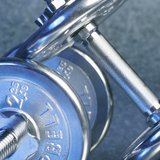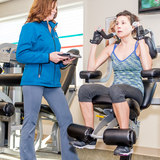It Hurts When I Go Like That by Jim Ganley
The greatest benefit from hiring a personal trainer, in addition to the sense of accountability, is the oversight needed in preventing injury. We’ve all heard the adage “NO PAIN, NO GAIN,” which may be true in part. For the really unfit individual, simply getting out of bed in the morning may be painful. Most of the negative bodily changes associated with a sedentary lifestyle have already been discussed. Chronic pain is also a part of this not so pretty picture and may put a genuine burden upon one’s enthusiasm for physical activity.
On the other hand, when properly managed, pain can be a useful tool whose function is to alert us to potential harm. For example, lacking pain receptors in the skin, were we to place a hand on a hot stovetop, we may be likely to leave it there until severely burned. Pain, fortunately, will cause us to instantly withdraw the hand, avoiding serious tissue damage.
It’s not always that simple. Pain is often difficult to grade for a number of reasons. What may be excruciating to one person, may be only a moderate discomfort to someone else. Also, someone new to exercise may have difficulty sorting out the variety of sensations part and parcel of physical activity above and beyond what we are used to. Neophyte runners often complain of a “stitch” in their side and breathlessness. People new to resistance exercise will inevitably encounter delayed onset muscle soreness attributable to the muscles being stretched out under load and inducing “microtrauma” to the involved musculature. Microtrauma is not visible to the naked eye, but with magnification of a needle biopsy under microscope will appear as a fraying of the muscle fibers. Typically the pain of delayed onset soreness is of no clinical significance.
At home, Springtime, 1958.
My friends and I had recently taken up the latest fad of Hula Hoops. Early one morning my father came to wake me to go to school, but I seemed to have been in no shape to get out of bed, much less make it to Sister Rosita’s third grade class.
“I can’t get up,” I told my father.
Dad gave me a puzzled look. “What’s wrong?”
I had a horrible pain in my abdomen and explained that I thought it might be appendicitis.
Dad seemed to know what was wrong.
“Did you do anything different yesterday, Jim?”
“Nope!”
Dad stroked his chin and smiled. “Nothing new? Are you sure about that?”
With my memory refreshed, it dawned on me. “Just played with a Hula Hoop for a few hours.”
I had to go to school regardless. Most of my classmates that day were doubled over with cramping abdominal muscles, waddling around as if doing The Green Apple Quickstep. Delayed onset soreness for sure.
Delayed onset muscle soreness is not necessarily a bad thing. It simply tells us that we’ve pushed a muscle out of its comfort zone. Repeated bouts of the offending exercise will lessen the soreness over time.
Other sources of pain may include physical trauma, infection, and arthritis, as well as age-related structural changes or serious illness. Pain may also be further classified as acute and /or chronic. Acute pain is the immediate discomfort from the body’s reaction to an offending agent. Chronic pain is the long-term discomfort which persists after that initial, pain inducing event.
Pain was first elucidated in the medical literature nearly two thousand years ago. “Dolor, rubor, and calor,” in the Latin, translated to mean pain, redness, and warmth, were the physical traits found to be most frequently associated with pain. It has long been known that pain is generated by a number of physiological events taking place within the body, including prostaglandin, cytokine, and cox-2 enzyme formation, as well as blood flow to the injured area, all of which is overseen by the sympathetic and parasympathetic branches of the nervous system. There may also be some sort of connection to one’s psychological state. The latter would seem to explain some of the long-term pain syndromes such as fibromyalgia, fibromyositis, and reflex sympathetic dystrophy. All of which may induce severe, localized pain, or vague, changing discomfort affecting different parts of the body. Most recently the term neurosomatics has been used to explain such conditions. The premise behind neurosomatics is that unresolved mental stress can and frequently does manifest itself in real, physical problems in the body.
Smolen Clinic, Manchester, NH 1990
Eva was an elderly, obese patient referred to us by her orthopedist for therapy to help manage her chronic pain. He had prescribed “gait training”, basically walking on a treadmill at 2 MPH for up to 20 minutes. Eva had been afflicted with chronic pain for quite some time. Each day when she presented for her appointment she would tell me, “It hurts here, today,” each visit indicating that the pain had migrated to a different part of her body. My staff and I thought that Eva had mastered what there was of her program, but were totally unprepared for its eventual outcome and apparent resolution. She had been trudging along on that treadmill with all of the vim and vigor of someone near the end of the Bataan Death March. Without warning she took one foot off the belt, placing it off to the side while the other foot remained on the belt, pulling her legs apart into a near split, and causing her to fall flat on her can onto the belt only to be spit off the back of that treadmill like an Easter ham in checkout at the supermarket.
One other staff member and I were instantly at her side, hoping that she hadn’t been injured. We helped her to her feet and were amazed that she was fine. More surprising still, two days later when she arrived for her next appointment, she had no reportable pain whatsoever.
At the next patient care meeting I surmised that if we could rig a controlled way to bounce patients off that treadmill we would have another therapeutic modality to add to our repertoire.
Of course incidents such as the above have caused me to wonder about the effectiveness of giving my malingering clients a good, swift kick in the butt. Instead, whenever someone whines that “It hurts when I go like that,” I tell them, “Don’t go like that.”
There are some who would lead us to believe that pain is a simple matter of mind over matter. My take on this is that if we don’t have a mind then nothing will matter.
About Integrity
Integrity Health is a franchise company residing in New Hampshire. We specialize in health coaching centers combining fitness with weight loss to optimize and promote optimal health. We are also the national purveyors of the RAMP Metabolic Fitness Prescription licensed by fitness professionals.
HEALTH COACHING LOCATIONS

491 Main Street
Gorham, NH 03581

1857 White Mountain Highway
North Conway NH 03860

Solutions For Fitness Centers

